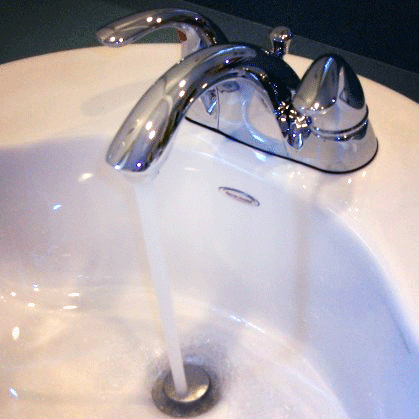Well Water Flow Rate Instructions
Well Water Flow Rate Instructions
Well water flow rate instructions make it easy determine your flow rate. The flow rate helps a great deal in determining the correct size of water filter you might need. And together with water quality information, you can determine the correct type of filter.

We STRONGLY recommend that all well water users that have a well pump and pressure tank, read the following instructions. Be VERY wary of anyone who would recommend any sort of water filtering or water softening without first insisting on this information. It is really easy to collect this info from around the home.
How do I determine my well water flow rate?
This is the single most important factor in determining what you need to do to get the right filter for a private well. Follow these well water flow rate instructions for a great result.
A: To determine your flow rate please follow these simple steps.
Open the NEAREST faucet or tap AFTER the pressure tank (But NOT the one ON the pressure tank). And let the water run until the well pump turns on. Immediately turn off the tap and time how many seconds the well pump runs from the time it came on until it shuts off. Then write down the number of seconds the pump ran.
Now get a container you can measure water in, such as an empty gallon milk container. Open the tap or faucet and fill the container. Then close the tap and dump the water down the drain. Fill the container again, and then pour it out again. Continue doing this and counting each gallon until the pump starts again.
Once the pump starts, shut off the tap and stop drawing water. Write down the number of gallons you counted until the pump started. If there are any partial gallons left over count those as well. Such as a total of 1.5 gallons, or 4.25 gallons. You now have the information to calculate the well pump flow rate. Just give one of our techs a call and tell him how many seconds you calculated on the first step. Then tell him how many gallons you were able to draw after that. And that is it.
Filter Size
He will then be able to tell you exactly what the flow rate is and which size filter you need. This information is essential to properly size any backwashing filter (such as iron filters and water softeners) or other flow rate dependent items such as Ultra Violet (UV) systems. You should always know your flow rate on ANY private well.
For example: The well pump ran for 30 seconds. And then you were able to draw 5.5 gallons before the pump started again. That means you have 11 GPM flow rate.
Things to remember when doing a flow rate check:
*DO NOT use a water hose when checking flow rates. If necessary have someone listen for the pump to turn on while you draw water.
*If you can’t hear the pump turn on and off, follow these instructions. When you have a pressure tank. Some where near it there will be a small box with some wires connected into it. This is called the pressure switch. Right when the well pump comes on it will make a distinctive “Click”. When the well pump goes off it will make another distinctive click. In this case you may need two people. One to draw water and the other to listen for the clicks.
*Variable Speed Well Pumps and Constant Pressure Well Pumps:
Most residential wells have conventional pumps and pressure tanks. Every now and then we will talk to someone who has a different type. These people usually know who they are because of the special nature of these pumps. If you have a variable speed pump or a constant pressure pump, please call in and ask for a level #4 tech to help you.
Flow rate is essential for backwashing filters for private wells.
Flow rate is especially important for backwashing filters for two reasons. If the flow rate is too low there may not be enough water pressure to lift the bed of media during backwash, which can in time damage the media. On the other end of the spectrum, too high of a flow rate can cause excessive media washout during backwash. While we do have guidelines in place for recommendations and proper sizing of equipment, there are a lot of factors at play in determining which size unit to go with a particular flow rate.
Another area of treatment in which flow rate plays an important role is the treatment of E. Coli or Coliform bacteria. When using an ultraviolet light to sterilize the water it’s crucial to make sure that your UV light is sized to match your flow rate, though in this instance over-sizing the unit isn’t of as much concern as under-sizing the unit. If the unit is under-sized the bacteria won’t be exposed to the UV light for a long enough time to be neutralized, leading to potentially harmful bacteria getting into your water.
For this same reason, when using chlorination and retention, it’s important to have at least 20 gallons of retention capacity for every gallon per minute of flow rate to ensure that the bacteria is in contact with chlorinated water for at least 20 minutes. Because there can be other factors in play when choosing or sizing a unit, we highly suggest calling one of our experienced water technicians at 1-800-684-0979 if there’s any uncertainty whatsoever as to what the best solution for you is.
-Water Filtration Wizard
Leave a Reply